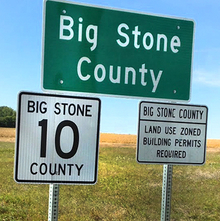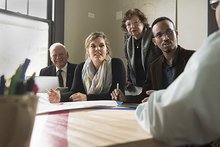Thriving in times of change
Three communities work to plan their futures
What makes us proud of where we live today is often the result of decisions made decades ago.
Community leaders and residents are making new choices in light of economic, technological, civic and demographic change. Will decisions made now make future generations proud?
University of Minnesota Extension brings education and applied research to all of Minnesota. “We are in the business of helping communities choose their future,” says Kent Olson, Extension’s associate dean for community vitality.
Big Stone County: Marketing quality of life
“While rural areas don’t grow as quickly as urban areas, they do attract 30- to 49-year-old residents who bring families, education and workforce opportunities,” says Ben Winchester, an Extension research fellow who calls this phenomenon the rural “brain gain.” Winchester helps rural communities see positive trends and embrace opportunities.
In the cities of Clinton, Graceville and Beardsley, Winchester’s message took hold. The rural communities have reached out to include all of Big Stone County and are working together to develop their tourism potential with assistance from Extension’s Tourism Center. “The ‘brain gain’ research has helped us to target our marketing message for tourism and to work to recruit workers to our region,” says Vicki Oakes, coordinator of a new MNBump.com and social media initiative that touts the benefits of life on that “bump” on Western Minnesota’s map. “It’s helping us build a sense of community across Big Stone County,” says Oakes. “We are excited that we have already grown an audience of people between the ages of 35 and 44.”
Barnesville: Turning the keys to local businesses over to the next generation
When Karen Lauer learned that 46 percent of business owners in Barnesville had no plan for what to do with their businesses when they retire, she knew it was time to act. One important Main Street business planned to simply shut its doors. “That was a red flag,” says Lauer, the director of Barnesville’s Economic Development Authority. “We knew that, as a community, we needed to encourage our businesses to plan for succession.”
Lauer’s insights came from what she learned from Extension’s Business Retention and Expansion (BR&E) program. BR&E involves community residents and leaders in the well-being of local business. “We encourage communities to build a team that will listen to business owners. Barnesville is acting on what they learned from those conversations,” says Michael Darger, Extension’s BR&E specialist.
Planning how to sell, pass on, or transform an established business is important, especially as baby boomers retire. Extension’s community economics educators have responded by studying the trend and helping communities consider options for addressing this change, such as Barnesville’s example. “Many of our local owners had been thinking about it, but had no clue where to start,” says Lauer. “Now, they are making connections and thinking about the future.”
Willmar lakes area: Growing new leadership
Five generations are working together in communities across Minnesota. Pictured: Members of the Vision 2040 team.
“Right now, five generations are working together in Minnesota’s communities and workplaces,” says Brian Fredrickson, Extension leadership educator. “The new digital generation, millenials, Generation Xers, baby boomers and builders each bring different perspectives to work and communities.”
Baby boomers are retiring from their positions as leaders on local boards, committees and city councils. Vision 2040, a project to envision the future of the Willmar area, is growing its own leadership through emerging local leaders. The program is careful to recruit participants who reflect the wide diversity of residents who live in the Willmar area — or, more importantly, who will be part of Willmar’s future demographics. Extension offers nine day-long sessions where emerging leaders network and strengthen skills in engaging residents and leading them to act.
“It’s a great success story,” says Audrey Nelson, a member of the program design team and the inaugural class. “When you understand yourself and others, you can find better ways to do things.”
The leadership change challenge
Five practices that lead communities to address change
Model ways to adapt to change or make it happen
- Clarify the positive values that can be brought to change.
- Gather and share information that brings perspective.
- Set an example. Invite newcomers. Adopt new technology.
Inspire a shared vision
- Get others involved in creating the future.
- Help others dream.
Challenge the process
- Search for opportunities that others don’t see.
- Experiment and take risks. Ask “why not?”
Enable others to act
- Foster collaboration among people and groups who don’t usually work together.
- Encourage others and help them succeed.
Encourage the heart
- Recognize the contributions and ideas of others.
- Celebrate small and large successes.
Based on the model by Kouzes & Posner
Related stories

Minnesota garlic seasons local foods project
Exploring new market access through Extension RSDP Backhauling Project

Minnesota tourism feels shifts in the wind
How the state's tourism industry is changing




